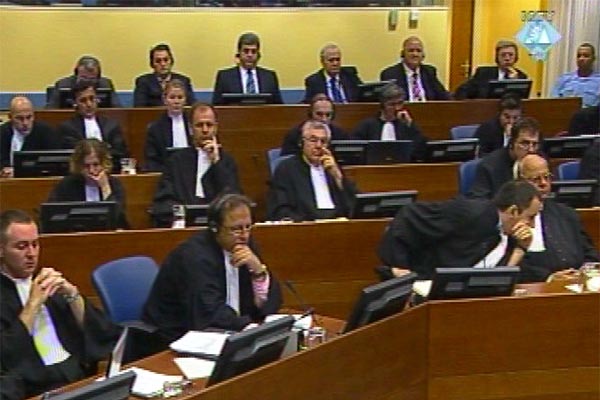Home
TRIAL OF MILUTINOVIC ET AL. OPENS AT ICTY
The prosecution delivers its opening statement at the trial of the six former political, military and police officials from Serbia, charged with participation in a joint criminal enterprise aimed, as stated today, “to change the demographic structure of Kosovo in order to continue and reinforce the Serb control over the province”
 Milan Milutinovic, Nikola Sainovic, Dragoljub Ojdanic, Nebojsa Pavkovic, Vladimir Lazarevic and Sreten Lukic in the courtroom
Milan Milutinovic, Nikola Sainovic, Dragoljub Ojdanic, Nebojsa Pavkovic, Vladimir Lazarevic and Sreten Lukic in the courtroom The campaign launched by NATO on 24 March 1999 against Serbia “gave the participants in the joint criminal enterprise an opportunity to do under cover of the war the things they could not do in peacetime,” prosecutor Thomas Hannis said today in his opening statement at the trial of the six former political, military and police officials from Serbia, charged with crimes against humanity in Kosovo in the first half of 1999.
In the dock are the then Serbian president, Milan Milutinovic; deputy prime minister in the federal government, Nikola Sainovic; Chief of the VJ General Staff, Dragoljub Ojdanic; commander of the 3rd Army, Nebojsa Pavkovic; commander of the Pristina Corps, Vladimir Lazarevic and the police chief in Kosovo Sreten Lukic. The only person missing is Vlastimir Lazarevic, former head of the Public Security Department, who is still at large.
They are all charged with participation in the joint criminal enterprise aimed at “changing the demographic structure in Kosovo, to continue and reinforce the Serbian control over the province”. Slobodan Milosevic, the then president of the Federal Republic of Yugoslavia, was also in the joint criminal enterprise, the indictment alleges. To realize the objective, the accused used the military and police assets under their command and control, and their joint plan and intent involved the commission of crimes.
The key factors the judges should bear in mind during the prosecution case are the concerted, systematic and widespread character of the armed campaign launched by the Serb forces on 24 March 1999; the large number of women, children and the elderly among the victims of the violence; the efforts made to cover up the crimes and eliminate the evidence and Milosevic’s “statement of intent” made in October 1998 before generals Naumann and Clark, when he announced that in spring, the Kosovo problem would be solved using the “Drenica model” from 1945 and 1946: the Albanians would be “rounded up and killed”. Among the key factors highlighted by the prosecutor are the removal from office in the military and police of those who were opposed to such policy and “the importance of Kosovo in the political rise and survival of Slobodan Milosevic”.
The result of the campaign of violence launched by the Serb forces under cover of the NATO intervention, the prosecutor alleges, were hundreds of thousands of people who were either deported or forced to flee from Kosovo, thousands of people killed, countless people who were robbed and stripped of their identification documents, men who were abused and women who were raped, thousands of homes that were burned, mosques, places of worship and cultural monuments that were razed to the ground. All this, the prosecutor said, was “not simply collateral damage of the conflict with the KLA nor a consequence of NATO air strikes”. As he contends, this was “systematic murder of civilians” and “a well-organized and coordinated action to deport people, in order to shift the ethnic balance in Kosovo”.
The trial continued in the afternoon, with an opening statement by the accused General Ojdanic and the testimony of the first prosecution witness.
Linked Reports
- Case : Sainovic et al.
- 2006-07-07 DRAGOLJUB OJDANIC’S OPENING STATEMENT
- 2005-11-23 GENERAL OJDANIC WINS PARTIAL VICTORY IN DISPUTE WITH NATO
- 2005-11-18 PAVKOVIC TEMPORARILY IN BELGRADE
- 2006-07-11 DEFENSE: KVM REPORT CONTROVERSIAL
- 2006-07-12 FORMER SCORPION TESTIFIES
- 2006-07-13 REASONS FOR EXCLUDING THE CRIMES IN RACAK, DUBRAVA AND PADALISTE FROM THE INDICTEMENT
